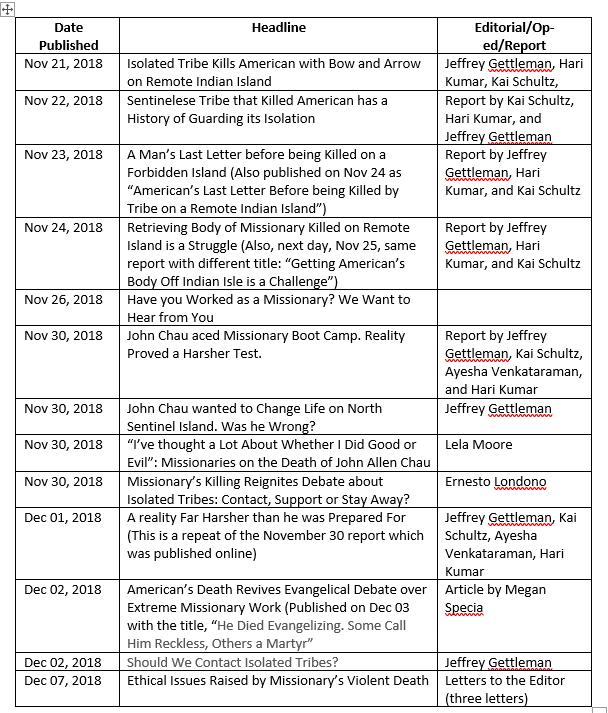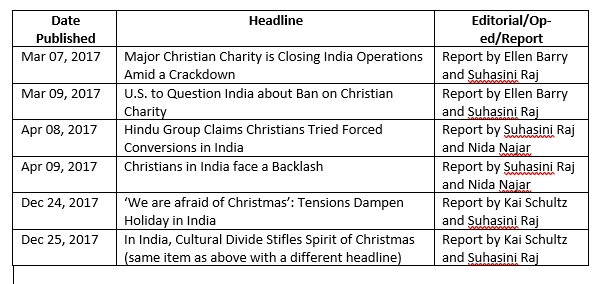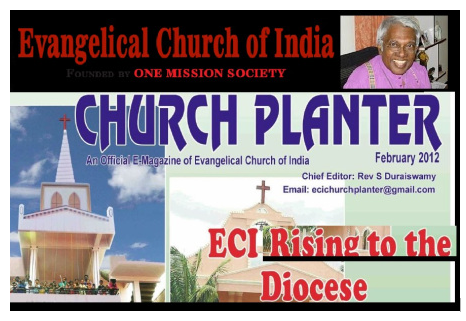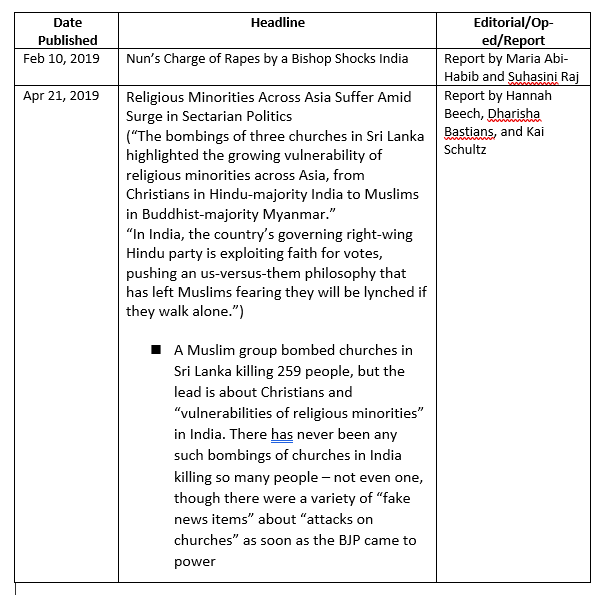The New York Times wants to Stick It to the Hindus, Go Soft on Christians
If you were to read The New York Times, however, you would not know about the clout that Christian groups exercise, and the variety of political activities carried out by them in the garb of religion and protection of minority rights.
As I keep reminding my students, you can’t make a case through just one example for that example could be an aberration, an outlier, and statistically could have occurred by chance. To show that there is bias, a slant, and an agenda we need to look more closely and see if there is a trend in the manner in which certain events are reported, certain issues are analyzed, and whether some issues/events are either not reported or under-reported.
So is the case with The New York Times and its coverage of Christians, Christianity, and Christian influence in/on India. European colonization of India has led not only to Indians learning English but English becoming the “link language” of modern India. Despite the fact that the Christian population (official figures) hovers around the 2.3 percent mark as per the 2011 Indian Census, the Christian influence on education, health, media is enormous, punching above its numerical weight, and drawing deeply from the enormous wealth that the British, Portuguese, and the French left for them in terms of prime urban land, and in charge of the large number of schools, colleges, and hospitals run by missionary organizations. Even the counting of heads of Christians and Hindus has become a Christian project, with vast resources pumped every year to bring the “word of God” to heathen Hindus. For example, the Joshua Project folks seem to have the kinds of resources drawn from their deep evangelical pockets to find out who is Christian among which group and what is the opportunity for converting yet another family, yet another tribe, and plant how many churches where with what consequences.
If you were to read The New York Times, however, you would not know about the clout that Christian groups exercise, and the variety of political activities carried out by them in the garb of religion and protection of minority rights. You will not find in The New York Times about the devious, monopolistic goals (self-proclaimed) of the Joshua Project and the evangelicals. The one mention of the Joshua Project and their nefarious goals in India is in a news item when the young American missionary, John Chau, sought to land on a remote island in the Andamans and was killed by the Sentinelese — shot with an arrow. The series of articles on the death of John Chau is a revealing look at The New York Times’ own religious sympathies and proclivities in India.
This is how the NYT report mentions the Joshua Project: “Ever since Mr. Chau had learned in high school through a missionary website, the Joshua Project, that the North Sentinel people were perhaps the most isolated in the world, he was hooked. Much of what he did the rest of his short life was directed toward this mission.” The reporters of this article, a combination of the NYT’s American stable and its New Delhi stable, do not have anything to say about the nature of the Joshua Project and their activities in India. The Joshua Project is merely a “missionary website”. The reporters characterize John Chau as a hero, as someone driven, committed, a martyr.
The long report, filled with a variety of details, mentions the increase in Christian missionary activities but does not offer one negative/critical evaluation of Christian proselytism and none of the societally destabilizing consequences of such proselytism efforts are included in the report. They report that what Chau was doing was illegal, but the harm he could have done to the islanders, and the arrogance of an American Christian willing to break the laws of another country in pursuit of his faith are in words and in a language that can only be described as uncritical of Chau’s “adventures”. And as if one report on this young, criminal missionary was not enough, there is a series of reports on his work and his activities, with each report offering in fine-grained detail what can only be characterized as a “heroic” but foolhardy mission. Not only did John Chau embark on a mission that could have decimated the Sentinelese, as Chau could have infected the isolated Andamanese with whatever disease he carried to which the Andamanese would have had no immunity, he bribed some local Andamanese fishermen to break Indian laws — fishermen who are now rotting in some jail for enabling this criminal Christian enterprise.
But we are getting ahead… So, pause and take a look at the headlines at the thirteen reports that the NYT published on this young missionary’s “adventure”. No, you did not get me wrong. The NYT offered its readers thirteen reports/analyses/letters to the editor on this young criminal’s “mission”, including this — “Have you worked as a missionary? We want to hear from you” (November 26, 2018). This call by the newspaper to hear from missionaries includes this invitation: “The Times would like to better understand the views and efforts of missionaries today”.

So, let us let the NYT offer us lessons in history, mythmaking, Christian evangelism, and the great, as yet incomplete task of making the world Christian:
Sample Headlines — The New York Times — January 1, 2018 to December 31, 2018

It will take another effort to go through each report, analysis, headline to unpack carefully the NYT attempts here to whitewash the supremacist, monopolist Christian project of making the world Christian. Not one of the headlines is sharp (if not nasty) as the headlines are about Hindus, Hinduism, and their alleged crimes or “exotic” worldviews; not one of the articles or reports includes a harsh indictment of the Christian project in general and this particular crime in particular. But, in contrast, let us look below and see how the NYT covered Christian matters in India the previous year, 2017.
Sample Headlines — The New York Times — January 1, 2017 to December 31, 2017

The first report, a long one, is about Compassion International, a Christian charity organization, being asked to shut its operations in India by the Indian Government because it was involved in proselytizing activities. In the report are claims by Christian missionary leaders that are unverifiable, and which the reporters don’t bother to pursue. The reporters, who have a lot of resources to do their research on the matter, fail to point out that hundreds of millions of dollars flow into India via American and West European church organizations. Unfortunately, no Indian newspaper has bothered to do the necessary research and point out not only the huge sums that flow into India, and how much of that money is diverted into church planting and missionary work, but also the kinds of deleterious effects that such proselytism and church-planting has had on families, communities, and whole regions of India. Much of Northeast India is now majority Christian, while even a few decades ago they were not. There is a tremendous amount of missionary activity, destabilizing proselytism, and political chicanery that Christian missionaries, mostly Indian, but completely funded by foreign church groups and agencies are involved in, especially in the South Indian states of Andhra, Telangana, Tamil Nadu, and Karnataka. It is only sporadic efforts by some concerned Indian media platforms and a book published more than a decade ago (Rajan & Kak, 2006) that bring out some of the information about these church-planting and proselytism activities and the political gamesmanship that Christian groups are involved in, including at the highest levels of the Catholic Church, as evidenced during last year’s general elections.

The other reports in 2017 show Christians at the receiving end of Hindu ire. When there is a concerted effort at making Christmas popular and a nationwide celebration in India, with all of its attendant materialistic, shopping-focused, crass celebration of wealth aspects, one should expect some pushback, some debate about what is good for society, and what it is indeed that should be celebrated by people. India is rich, abundant in its cultural and spiritual wares. Why seek to marginalize them by overwhelming modern India with foreign traditions? When poor Indian families in cities and villages clothe their little babies and children in cheap China-made Santa Claus outfits and put little plastic “Christmas trees” in their poor tenements there is surely something insidious, dangerous, crass, and vulgar that is sought to be inserted into Indian culture. No Hindu is allowed space and a voice in the NYT articles, except those who mouth inanities about Christmas as a sign of peace and love, or some inarticulate local political goon, dressed in saffron, who mouths off “Jai Shri Ram”. Why can’t there be space in the NYT’s op-ed pages for concerned Indian voices about the monopolistic nature of Christianity, the insidious proselytism efforts that has led to major demographic shifts in India, and the crass symbolism of a shopping spree-filled Christian celebration?
Well, we could very well be asking for the moon, would we not?
So, in winding up this analysis in the continuing saga of the NYT coverage of Indian matters, let us look at what the NYT stable of reporters and correspondents cooked up and delivered their readers in 2019:
Sample Headlines — The New York Times — January 1, 2019 to October 31, 2019

In the one report of a Bishop arrested on rape charges (the Kerala Bishop Franco Mulakkal was actually arrested in September 2018 on charges brought by a nun who claimed that the Bishop had raped her repeatedly between 2014 and 2016), the NYT is late by a few months in reporting on this matter and hidden in the report is the culture of intimidation, violence, and shaming in the church, where the Bishop outed the nun who had accused him of rape by publishing her photograph. Why did the NYT not spend time and resources in doing some investigative work about not only Father Mulakkal but other church leaders in India who have been accused of rape and other crimes, including the illegal selling of babies by Mother Teresa’s nuns? When the newspaper can publish some dozen or more reports, analyses, letters, and opinion pieces on John Chau’s criminal mission to preach to the Sentinelese, why not take a deep look at how and where the money to proselytize comes to India, and how some of India’s church leaders are involved in varieties of crimes and political gamesmanship?
And in the second report, nothing to do with India, we see again the insidious nature of reporting in The New York Times. Sri Lanka witnessed one of the most horrendous acts of Islam-inspired terrorism, and the NYT leads its report with charging Hindu-majority India of discriminating against Christians!
In the three lists above we have a representative sample of the small number of articles and editorials that NYT has published about the status of Christians in India. In 2017 the focus of the reports is mostly on the presumed threats to the Christian minority, and where Christians purportedly feel afraid of celebrating Christmas. What the NYT has not published over the decades reporting about the status of Christians in India is the tens of billions of dollars poured into India by American and West European church groups, NGOs, and activists to encourage conversion of Hindus to Christianity, and in the guise of offering education, medical care, and social services seduce individuals to convert, who in turn pressure their family members to convert, and those families then are trained to persuade the community to convert. The Joshua Project (joshuaproject.net), whose aim is to make the world Christian, is not shy about its plans for India (Bhattacharjee, 2018), but there has not been one report about their activities in India by NYT’s reporters. The Christian proselytism program is a couple of milliennia old, and so it did not come as a surprise, I suppose, when Pope John Paul II came to India in 1999 and had the audacity to pronounce that Christianity had spread through Europe in the first millennium, through the Americas and Africa in the second millennium, and that it would spread through Asia in the third millennium!
In 2018, NYT’s reporters were obsessed about the killing of John Chau, an American missionary, who went out into the protected Sentinelese islands, where India’s remotest tribes live, and was killed by the Sentinelese. The actions of a lone, foolhardy, dangerous missionary (the Sentinelese tribes have had no contact with the “outside” world, and even one contact by an outside could end up infecting them with a deadly disease) got reported over two weeks by a dozen reporters/correspondents/columnists of the newspaper! Hindus have been demonized by Christians over the centuries, and the recent attempts by Christians, after India gained independence, with the help of Christian-majority Western nations has simply morphed into a whole new project of “saving Hindus” (Kishwar, 2019). NYT reporters’ implicit racism, their hegemonic agency and religious supremacism leak through in their excessive and obsessive coverage of the John Chau incident. To these reporters and correspondents “religious freedom” — the right to spread messages, however insidious, destabilizing, unscientific, supremacist and unverifiable they are — is more important than reporting fairly and with a clear eye the effects of Christian supremacy and Christian proselytism.
References:
Bhattacharjee, K. (November 23, 2018). “Christian evangelism and the Joshua Project: An existential threat to Hinduism,” https://www.opindia.com/2018/11/christian-evangelism-and-the-joshua-project-a-conspiracy-against-hinduism-india/
India Facts (August 26, 2015). Church Planting in India via Foreign NGO Funding: A Report on their Modus Operandi. http://indiafacts.org/church-planting-in-india-via-foreign-ngo-funding-a-report-on-modus-operandi/
Kiswhar, M. (June 2019). “Why do Christian Missionaries dislike Modi and the Rashtriya Swayamsevak Sangh?”, Hinduism Today, https://www.hinduismtoday.com/modules/smartsection/item.php?itemid=5936
Rajan, R., & Kak, K (Ed.) (2006). NGOs, Activists and Foreign Funds: Anti-nation Industry. Chennai: Vigil Public Opinion Forum
Featured Image: Everyday Feminism
Disclaimer: The opinions expressed in this article are the personal opinions of the author. IndiaFacts does not assume any responsibility or liability for the accuracy, completeness, suitability, or validity of any information in this article.


